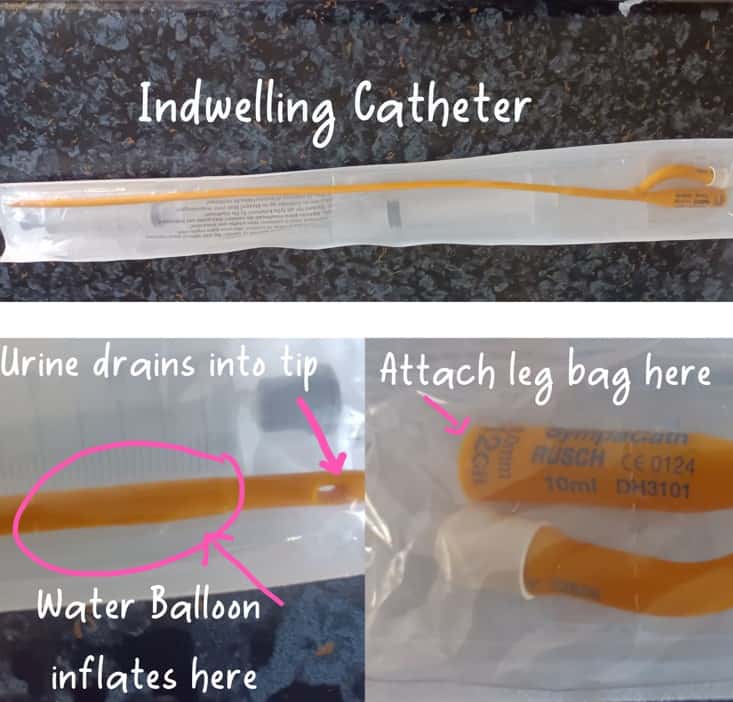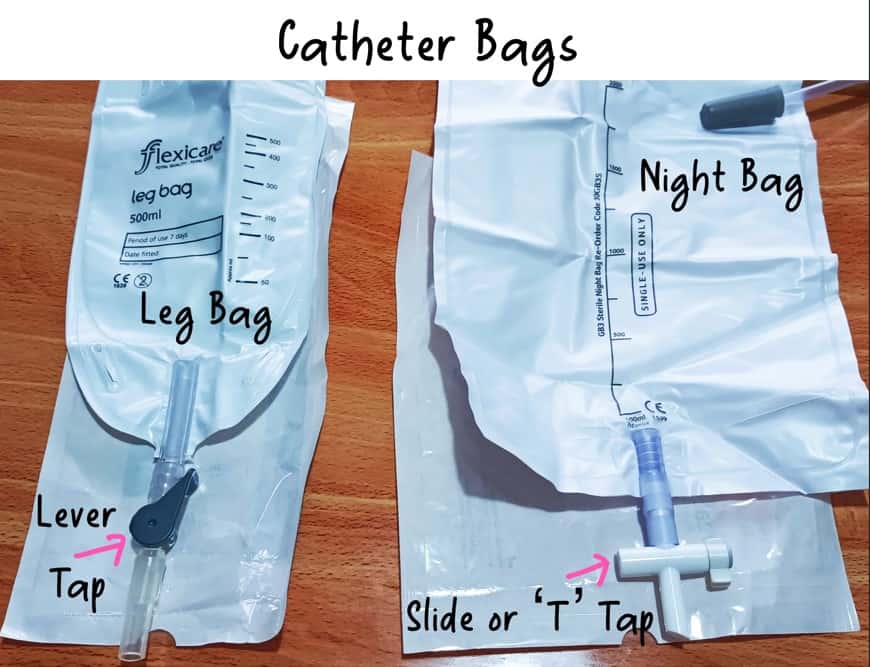An indwelling catheter may be fitted for medical reasons, and it can be difficult for your loved ones and their caregivers. We’ve had an indwelling catheter in now for just over 3 months, and we’ve learnt a few things that I wished I’d known about before. I think it will be useful to share our learnings with you – other newbies catheter users, whether they are independent, have dementia, or have caregivers to support them.

- What is an indwelling catheter?
- 1. What are Indwelling Catheters like the first few days after insertion?
- 2. Indwelling Catheter's leak!
- 3. Catheter Leg Bag Sleeve
- 4. Catheter Night Bag
- 5. Indwelling Catheter Can Get Blocked!
- 6. Catheter Bags Need To Be Emptied!
- 7. Night Catheter Bags and Human error!
- 8. Catheter Bags Aren’t All The Same!
- 9. Catheters & UTIs
- 10. Indwelling Catheters Make It Easier to test for a UTI.
- 11. Constipation & Indwelling Catheters
- Frequently Asked Questions
What is an indwelling catheter?
Indwelling catheters are also referred to as “ Foley Catheters”, named after the inventor Frederic Foley.
An indwelling catheter is where a drainage tube is inserted through the urethra into the bladder. After insertion, a water balloon is inflated to secure the catheter, stopping it from falling out and urine from leaking out. Urine drains into the catheter as the bladder fills and then into a drainage bag attached or can be directly released into the toilet with a catheter release valve where no bag is worn. The catheter is usually inserted and changed by a medical professional, although some caregivers can be shown how to do this for their loved ones.
Certain types of catheters can be fitted independently. Refer to the FAQs below for more information on the other types of catheters available.

1. What are Indwelling Catheters like the first few days after insertion?
After a catheter is inserted, you may feel pain and discomfort for the first few days. You may see blood in the urine, cloudy urine and bits of debris. You might feel sore from the insertion or feel pain as your body reacts to the insertion of a foreign body. A common side effect of having a catheter is bladder spasms as your bladder squeezes, trying to push out the balloon. Bladder spasms should calm down after a few days.
You can read our full experience after the first days after insertion in this article, “First Days Dealing with a Catheter “
If you find that you’re still experiencing pain, then it’s worth getting it checked out and ensuring the indwelling catheter has been fitted correctly. If things don’t settle after a few days, like pain from bladder spasms (your stomach will hurt), then they may prescribe medication to help. But usually, after a few days, the urine will clear from blood or being cloudy. If that continues or returns, then always refer to your doctor or relevant health care professional to check for infection.
2. Indwelling Catheter’s leak!
Yep, you heard me – an indwelling catheter can leak, or urine can bypass the catheter. It can cause a leak because it may have been fitted incorrectly, you may experience bladder spasms that mean the catheter moves, it could leak due to a kink in the line causing the flow to reduce or stop completely, and urine bypasses (leaks) into your underwear. This means you may still need to wear/carry some kind of incontinence protection like a pad or incontinence pants to ensure that you don’t have an accident.
In our case, due to spinal issues & dementia, mum wears incontinence pants, and we have had several leakages. However, the nurses involved waited for it to settle on its own rather than change the catheter as urine was also still draining into the leg bag, so there was no blockage. Simply shifting positions for mum helped stop the problem.
Having a pad under the catheter is useful to catch any leaks and a basin under the night bag stand/hanger in case it leaks will save you a lot of effort later!
3. Catheter Leg Bag Sleeve
Your urine will drain into some kind of bag that is usually attached to your leg using straps. What they don’t tell you is that you can also use a sleeve to help support the weight of the bag.
We found that the leg straps cut into mum’s skin as the urine bag became fuller. The sleeve had another significant effect for someone with dementia as it hides the bag (not tubing) and reduces the risks of the catheter being pulled or tugged at, causing more discomfort, leakage or pain.
The Urology department that fitted the catheter never once suggested this as an option for mum, even though I explained that this was a risk for mum with Alzheimer’s. Only once we were discharged to community care did the district nurses mention it as an option. You can purchase the ones we use from Amazon here (just measure to get the right size), or if you’re lucky, get them supplied by your local incontinence team for free.
4. Catheter Night Bag
The catheter leg bags used during the day can only support a certain amount of urine, ours will take 500ml, but some bags go up to 750ml. However, at night you’re not going to be getting up to drain it regularly or have someone do it for you. We have a 2 litre night bag, but you can also get ones that are 3 litres.
So you need to link an overflow night bag to the daytime bag with the drainage switch open, so urine passes through to the night bag. The night bag is then attached to the side of the bed using a hanging attachment or onto a catheter stand (make sure the bag isn’t touching the floor to keep it sterile – see below). Larger capacity bags are also available. It helps not to empty the day leg bag fully before linking the night bag, as a small amount of urine can be used to test that the urine is flowing into the night bag & no air bubbles exist.

5. Indwelling Catheter Can Get Blocked!
Indwelling catheters can become blocked because of kinks in the tubing from the urethra to the bag because it’s been attached too tightly to the leg, or because of some kind of debris being expelled in the urine or because of something called encrustation.
It’s a good idea to check the catheter bag at regular intervals to ensure it’s not blocked in any way and urine is outputting into the catheter leg bag. The same applies to the night time bag. Kinks or air bubbles can prevent drainage. A small movement of the tubing can usually correct that, and you’ll see the buildup of urine drain into the bag once corrected.
If the blockage isn’t clear, then contact your nurse or medical professional for help.
It’s useful to have spare catheters at home in case of blockages or infections.
6. Catheter Bags Need To Be Emptied!
That’s an obvious one, you would think, but it’s amazing how easy it is for time just to pass by, and you realise you’ve not emptied the bag in a long while, and it’s full. If you’re the one wearing it and are physically able to empty the bag yourself, the weight of it pulling as it becomes fuller on the side of your leg will alert you.
But for someone with dementia, limited physical mobility, or paralysis, it becomes trickier without having some kind of schedule to alert you or your loved one to empty the bag. The first few days with a catheter bag are about learning how much output is produced and how often it needs to be emptied.
I have my phone set up with a timer to remind me to check. On certain days mum may not drink a lot or drink more at different times of the day. I know that mum’s catheter bag will be getting fuller more quickly in the evening as she consumes a lot of liquid then vs during the day.
7. Night Catheter Bags and Human error!
Attaching a night bag relies on the person connecting it correctly, ensuring the linked daytime bag drainage valve is open for it to output to the night bag.
But despite our best efforts, our care workers have forgotten to check that on more than one occasion and left the drainage on the daytime catheter bag closed. Before you go, oh no, that’s not right. As mum’s caregiver, I have done it also (once!) where I believed that I had opened the drainage but hadn’t. So again, I would advise that you do some kind of nightly checks before turning in for the night. Check that the drainage is working correctly, that it’s open, and there are also no blockages – a small kink in the tubing can stop the bag from draining effectively.
8. Catheter Bags Aren’t All The Same!
The main differences in Catheter bags are how they drain & how often they need to be changed. You have different types of outlets that need to be opened in order for the day or night catheter bag to be emptied. You may receive a catheter bag with a T-Tap or slide option or the lever type on the catheter bag to allow for drainage.
You can also get single-use catheter bags or bags left intact, usually for a period of time before being replaced. For example, our night time bags are single-use and need to be changed every day, but our daytime leg bag is only changed once a week.

9. Catheters & UTIs
A catheter is a foreign object that can allow potential bacteria to get into your body. The longer a catheter is in place, the more opportunities exist for bacteria to enter the bladder. They are known as Catheter Associated Urinary Tract Infections (CAUTI) and are one of the most common infections in hospital settings for patients with indwelling catheters.
Bacteria can also enter the urinary tract through contamination of equipment, vaginal or rectal skin. bacteria around the urethra, bacteria on the catheter tube -all can result in UTIs.
If you have cloudy, smelly urine, blood in the urine, or are experiencing any pain, then talk to your medical professional to be tested for CAUTI and to try to determine what’s causing your symptoms.
10. Indwelling Catheters Make It Easier to test for a UTI.
We’ve learnt the hard way that this isn’t necessarily true. You’d think it would be easier to turn the tap or slide to drain some urine from the leg bag and transfer it to a test tube for in-house testing or to be sent to a hospital lab to grow the bacteria & identify the correct antibiotic for the infection.
But, a sample can be compromised by poor handling of the catheter, touching the drainage bag against the emptying vessel, etc, from your skin. A lot can impact getting a ‘clean catch’ urine sample.
The reality is having a catheter fitted means some bacteria will be in the bladder. Biofilm can develop on the catheter and attract more bacteria which could result in a compromised sample.
It’s also not recommended to take a sample from the drainage bag (something we weren’t told about until our 4th comprised sample was sent in).
It is advised for those with catheters to have urine samples extracted from the catheter sampling port, not the catheter leg bag or the water balloon valve.
11. Constipation & Indwelling Catheters
Constipation can cause issues for people with an indwelling catheter. If you’re constipated, a full bowel can press against the bladder and obstruct the urine flow into the catheter. It can also cause leaks or bypassing if you have to strain to make a bowel movement.
So it’s important to take in enough fluids, varied diet and any medications prescribed to avoid becoming constipated. It can be uncomfortable and painful. You can read more tips on managing constipation in this article.












